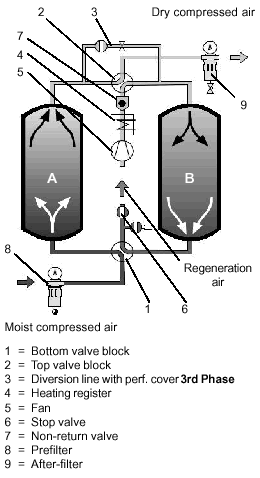<BR> Fig. 5.16:
Op. diagram of an adsorption dryer,
external hot regeneration
Fig. 5.16:
Op. diagram of an adsorption dryer,
external hot regeneration | 1st Phase
The drying tank B is slowly heated to the necessary regeneration temperature by the flow of hot air. Once the regeneration temperature is reached, the water releases itself from the Adsorption material. The fan continues to supply hot regeneration air through drying tank B. This flow of regeneration air takes on the moisture and transports it into the open through an outlet valve.
2nd Phase
In a cooling phase the operating temperature drops back to the temperature of drying tank B. For this purpose the heating register of the fan is switched off and cold air from the atmosphere is directed through the drying tank.
3rd Phase
At the end of cooling, dry, relaxed compressed air flows from the compressor and through the drying tank, in order that the atmospheric does not bring moisture back into the dryer.
Features
- Economical with high volume flows
- Higher regeneration temperatures allow a lower pressure dew point.
- Low additional consumption of compressed air. Only a small part of the regeneration air is taken from the pneumatic system.
- Prefiltration of inlet air.
A pre-filter removes most of the oil, water droplets and dirt particles from the compressed air.
- Postfiltration of dried compressed air.
Drying materials taken with the compressed air from the drying tank must be filtered out of the compressed air.
|